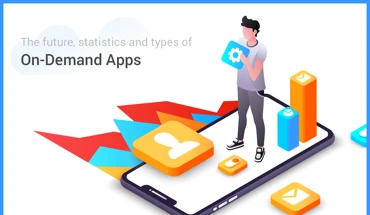- All
- B2C eCommerce
- B2B eCommerce
- Composable Commerce
- Headless Commerce
- Magento
- Digital Asset Management
- Jewelry and Diamond
- Digital Experience Platform
- Mobile Commerce
- Web Application
- Digital Marketing
- Replatforming
- Grocery App
- Furniture and Home Decor
- Digital Commerce
- Adobe Commerce
- Shopify
- Product Information Management
Top On-Demand Apps: Key Stats and Market Insights – Infographic

What will you do when you’re in the office and have so much work on your desk that you can’t spend extra minutes rushing out for lunch?
The answer is simple! Simply open your App Store and search for “Food Delivery App” and you’ll likely find many nearby restaurants providing on-demand services.
Now that is the role that on-demand apps have filled within the last decade. Connecting people who need help with getting something done to those who are ready to provide instant solutions to those problems.

Embed this infographic on your site
In this infographic article, we rely on statistics gathered on the web to try and predict the future of the on-demand app industry. We’ll also introduce you to the world’s most prominent on-demand apps.
Who are using on-demand apps?
According to Harvard Business Reports, the on-demand economy attracts more than 22.4 million consumers annually with spending somewhere in the region of $57.6 billion. All these on-demand services include freelance services, home services, transportation, food & grocery, health services, and other similar services.
Now, 49% of on-demand app consumers are millennials, while 30% of consumers are between the ages of 35 to 54. Going by these figures, one would not be wrong to expect more growth and increased activity in the on-demand app industry.
For on-demand app service providers to continue meeting the need of its most popular users outlined in the image above, the predictions are that:
- On-demand services will become more personalized.
- On-demand apps will allow sellers to directly interact with the seller and remove the need for intermediaries and platforms that charge high commissions for facilitating transactions.
- On-demand apps will generate more demands for product or service online.
- On-demand apps will continue to help millennials to monetize assets, skills and time.
- It will also facilitate service providers to meet needs instantaneously anywhere.
Influence of On-demand Apps in Service Industry
- Food Ordering
Food vendors can now reach consumers on a large scale via an on-demand app. The result is fulfilling more orders and maintaining a flexible menu based on consumer demands.
- Doctor on-Demand
The provision of medical care is no longer restricted by the location or time when a patient needs assistance. The result is a reduction in the number of medical emergencies as well as the death rate.
(adsbygoogle = window.adsbygoogle || []).push({});
- Beauty/Salon
Anyone can now request the service of a beauty specialist based on their schedule while providers of such services can enjoy more flexible working hours.
- Coaching / Tutor
The presence of on-demand apps has optimized the whole idea of hiring private tutors who have knowledge across different fields and are ready to teach at anytime their learner finds convenient.
- Pet Care
Instead of catering to only clients who live within a particular geographical area, pet care providers can now move into other regions with higher earning potential and also diversify the range of solutions they offer.
- Logistics
The use of On-demand apps for logistics continue to grow and is tipped to get to a point where a larger percentage of millennials prefer to use these applications instead of the traditional methods.
- Wine / Alcohol
Within the last few years, we witnessed the emergence of on-demand apps serving the liquor industry. Now people can order for their favorite drinks and have them delivered at their doorstep or warehouse within a reasonable time.
- House Cleaning
Instead of going house-to-house to ask homeowners whether they need cleaning services, innovative house cleaners use an on-demand app to connect with their potential clients.

- Laundry
Laundry service men or companies can now offer their expertise to across-border clients, thus, increasing chances of setting up in multiple regions and providing more employment opportunity.
- Maintenance
The rise of on-demand apps reduced the difficulty that individuals and companies face while trying to hire maintenance and repair service providers, especially when there’s an emergency such as a vehicle breakdown.
- Text / Cab Services
Despite the prevalence of social media services and e-mail, large organizations still employ on-demand apps to harness the power of text messaging to reach their audience in areas with poor or no internet connection.
People can also request rides to various locations anytime with their mobile phones.
- Fitness
With many preferring to use a mobile app than visiting a website, fitness coaches and similar entrepreneurs can deliver their services and acquire new clients via an on-demand app designed for such a purpose.
Statistics of On-Demand Mobile Apps
1) Type of User For On-demand Apps
Although a lot of people use on-demand apps for different purposes, the following statistics highlight the characteristics of a majority of people use the channel.
- 45% of these app users have a degree or even higher than that.
- 68% of the users have an annual income of $50000.
- 59% of the user of on-demand apps are male.
- The 55% of the on-demand app users are the people between the age group of 25 and 44 years.
- 47% of the users have an annual income of $75000.
- 54% of the app users are the suburb residents while only 18% of them are inner-city residents.
2) Financial Allocation
If the reason why a startup decides to solve a common problem by creating an on-demand app is for money, then they are likely not going to face disappointment if they get it right.
The transport and food-delivery industry witnessed a combined $11.4 billion increase while the other categories recorded a $7.6 billion growth.
On a general scale, these financial allocation figures should clock $56 million by the end of 2019 and also hit an all-time high of $93 million by 2022.
3) The High Rise In Demand
As the years go by, millennials are waking up to the reality that they could save more time and get more things done by using on-demand apps. This adoption and demand are responsible for the tremendous growth we have witnessed in the industry as many users now see the use of on-demand services as a way of boosting their economic status.
- The revenue in the on-demand app industry was $14 billion back in 2014, but the increase in demand means that it is set to reach the heights of $335 billion by the year 2025.
4) Grab Investors Investment
Time and again, we read news about one app-startup securing a particular amount of venture capital by mega companies who see the great potential even when not so much is visible to the public eye.
Well, the most successful on-demand apps need massive investment, and VCs and angel investors are always ready to provide the resources.
Uber and Airbnb are examples of successful startups whose idea got adequate investment, and they are now one of the most widely used apps around the globe.
Investment rounds focused on funding on-demand startups that started in 2014 ended with a figure of $74 billion and $102 Billion in the last quarter of 2017. Given the popularity, we can expect those number to keep growing significantly in 2019 and beyond.
Meanwhile, according to the latest PwC report, the market for On-demand mobile apps and websites will reach a significant value of $335Billion by the year 2025.
5) It’s Easy To Use On-Demand Services
It was only in 2016 that people started to know about the high level of convenience attached to using an on-demand app. Then, there were only 20% of the US people who knew and were using on-demand mobile apps.
Impressively, the number reached 34% by the end of 2017 may like hit 50% before the end of 2019.
What do users do on on-demand apps?
70% of the on-demand app users use it to search for the services they want to hire online while 62% of the used the apps to track the live status of the service they ordered.
At present, getting an instant and easy connection with the service providers is the main agenda of using the app. Also, the user can make the payment to a service provider or the third-party platform through the app and know exactly when the service is being provided.

On-demand users spend on an average $57.6B annually
The fact that on-demand service providers bring in a lot of revenue annually cannot be overemphasized.
However, the graph below shores than eCommerce stores or online marketplaces owned a fair majority of the market share with the transportation sector worth roughly 20% of the former. Food and grocery come next, followed by the diverse industries with combined average spending of $16.5 billion.
Types of on-demand delivery apps
Based on the category of buyers and users that make up the gig-economy, on-demand applications are divided into three types:
1. Enterprise to Person (E2P) / Business to Consumer (B2C)
E2P or B2C on-demand apps facilitate transactions of goods or services between providers and customers. In other words, a business makes money from assigning its employees to meet the needs of a consumer who pays the price for the service rendered.
McDelivery, Booking.com, and Starbucks are examples of B2C apps.
2. Enterprise to Enterprise (E2E) / Business to Business (B2B)
B2B on-demand apps are mobile solutions created to connect businesses. These apps support transactions globally
Cargomatic, Eventio, and Catalant are good examples of B2B apps.
3. Person to Person (P2P) / Consumer to Consumer (C2C)
These on-demand apps serve as a platform for users to exchange products or services. Customers can sell to or buy from other customers via a C2C on-demand app.
Successful platforms that use this model include BlaBlaCar, eBay, and Etsy.
Some Successful On-demand Apps
Although there are millions of on-demand apps roaming the market and meeting different user needs, the ones listed below are popularly used by millennials and thus, represent a large chunk of the on-demand app market share:
-
- Uber
- Postmate
- Task Rabbit
- Netflix
- Rinse
- Medicast

